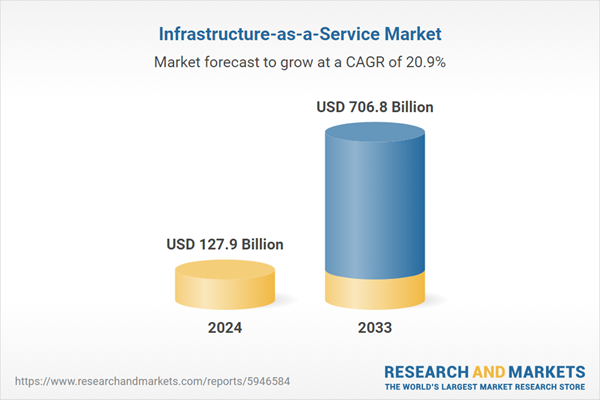Infrastructure-as-a-service (IaaS) is a cloud computing model that offers businesses access to fundamental computing resources over the internet. It allows cloud providers to manage and deliver a range of infrastructure components, such as virtualized computing resources, including servers, storage, and networking. It provides organizations with the flexibility to scale the information technology (IT) infrastructure up or down according to their requirement and eliminates the need for extensive on-premises hardware investments. As it aids in streamlining IT operations and reducing capital expenditures, the demand for IaaS is rising across the globe.
Infrastructure-as-a-service (IaaS) is a cloud computing model that offers businesses access to fundamental computing resources over the internet. It allows cloud providers to manage and deliver a range of infrastructure components, such as virtualized computing resources, including servers, storage, and networking. It provides organizations with the flexibility to scale the information technology (IT) infrastructure up or down according to their requirement and eliminates the need for extensive on-premises hardware investments. As it aids in streamlining IT operations and reducing capital expenditures, the demand for IaaS is rising across the globe.
- Public Cloud
- Private Cloud
- Hybrid Cloud
Hybrid cloud represents the largest market segment
The report has provided a detailed breakup and analysis of the market based on the deployment type. This includes public cloud, private cloud, and hybrid cloud. According to the report, hybrid cloud represented the largest segment. A hybrid cloud is a deployment model that combines elements of both public and private cloud environments and offers a combination of on-premises and off-premises infrastructure. In this setup, critical or sensitive data and applications can be hosted on a private cloud to provide enhanced security and control, while less sensitive workloads can run on a public cloud for cost-efficiency and scalability. In addition, this deployment type addresses the need for flexibility and agility in modern enterprises. It allows businesses to leverage the advantages of both private and public clouds, optimize resource utilization, and ensure data security and compliance.Breakup by Solution:
- Managed Hosting
- Disaster Recovery as a Service
- Storage as a Service
- Colocation
- Network Management
- Content Delivery
- High Performance Computing as a Service
- Others
Disaster recovery as a service accounts for the majority of the market share
The report has provided a detailed breakup and analysis of the market based on the solution. This includes managed hosting, disaster recovery as a service, storage as a service, colocation, network management, content delivery, high performance computing as a service, and others. According to the report, disaster recovery as a service represented the largest segment. Disaster recovery as a service (DRaaS) is a cloud-based solution that is designed to ensure the continuity of business operations in the event of a disaster or data loss. It provides organizations with a cost-effective and reliable way to replicate and recover their critical information technology (IT) infrastructure and data in the cloud. This approach eliminates the need for traditional and resource-intensive disaster recovery methods, such as maintaining off-site backup data centers. DRaaS assists in reducing downtime by enabling rapid failover to a secondary IT environment hosted in the cloud and providing enhanced scalability.Breakup by End-User:
- SMBs
- Large Enterprises
Large enterprises hold the biggest market share
The report has provided a detailed breakup and analysis of the market based on the end-user. This includes SMBs and large enterprises. According to the report, large enterprises represented the largest segment. Large enterprises are typically characterized by their substantial scale, extensive operations, and complex IT infrastructure requirements. Large enterprises have unique needs and challenges that shape their demand for cloud services. For large enterprises, cloud computing, including IaaS, platform-as-a-service (PaaS), and software-as-a-service (SaaS), offers several advantages. It enables them to scale resources dynamically to support their vast workloads, improve cost management through pay-as-you-go models, and enhance agility in response to rapidly changing market conditions. Furthermore, large enterprises often seek robust security measures, compliance support, and customization options in their cloud solutions to align with their specific industry regulations.Breakup by Vertical:
- IT and Telecom
- Banking, Financial Services, and Insurance (BFSI)
- Healthcare
- Retail and E-commerce
- Government and Defense
- Energy and Utilities
- Manufacturing
- Others
IT and telecom dominate market share
The report has provided a detailed breakup and analysis of the market based on the vertical. This includes IT and telecom, banking, financial services, and insurance (BFSI), healthcare, retail and e-commerce, government and defense, energy and utilities, manufacturing, and others. According to the report, IT and telecom represented the largest segment. The IT and telecom vertical comprises a wide range of businesses that provide information technology services, software solutions, telecommunications infrastructure, and connectivity services. This sector plays a vital role in driving technological advancements across various industries and is a significant consumer of cloud services. Within IT and telecom, cloud services enable companies to scale their infrastructure efficiently. Moreover, IT and telecom companies leverage the cloud for enhanced connectivity and communication services, such as voice over internet protocol (VoIP) and unified communications.Breakup by Region:
- North America
- United States
- Canada
- Asia Pacific
- China
- Japan
- India
- South Korea
- Australia
- Indonesia
- Others
- Europe
- Germany
- France
- United Kingdom
- Italy
- Spain
- Russia
- Others
- Latin America
- Brazil
- Mexico
- Others
- Middle East and Africa
North America exhibits a clear dominance, accounting for the largest infrastructure-as-a-service (IaaS) market share
The market research report has also provided a comprehensive analysis of all the major regional markets, which include North America (the United States and Canada); Asia Pacific (China, Japan, India, South Korea, Australia, Indonesia, and others); Europe (Germany, France, the United Kingdom, Italy, Spain, Russia, and others); Latin America (Brazil, Mexico, and others); and the Middle East and Africa. According to the report, North America accounted for the largest market share.North America held the biggest market share due to the increasing demand for cloud services. Additionally, the growing focus on data security and compliance among businesses of various sectors is offering a positive market outlook. Apart from this, the rising deployment of advanced cloud solutions is contributing to the growth of the market. In addition, the presence of major cloud service providers that provide a wide variety of cloud solutions is propelling the growth of the market.
Competitive Landscape:
Key players in this industry are continuously expanding their data center infrastructure globally. This expansion ensures proximity to customers, reduces latency, and enhances the performance and reliability of their services. In addition, IaaS providers are diversifying their service offerings to cater to a broader range of customer needs, such as providing specialized services like databases, machine learning (ML), and the Internet of Things (IoT) solutions. Apart from this, major manufacturers are investing heavily in security measures and compliance certifications to assure customers that their data is safe in the cloud. In line with this, they are developing hybrid and multi-cloud solutions that seamlessly integrate on-premises infrastructure with cloud resources.The report has provided a comprehensive analysis of the competitive landscape in the market. Detailed profiles of all major companies have also been provided. Some of the key players in the market include:
- Amazon Web Services, Inc
- Cisco Systems Inc.
- DXC Technology Company
- Dell Technologies, Inc.
- Fujitsu Limited
- Google LLC
- International Business Machines (IBM) Corporation
- Microsoft Corporation
- Oracle Corporation
- IONOS Cloud Inc.
- Rackspace Technology Global, Inc.
- Red Hat Inc.
- Redcentric PLC
- VMware, Inc.
Key Questions Answered in This Report
1. What was the size of the global infrastructure-as-a-service (IaaS) market in 2024?2. What is the expected growth rate of the global infrastructure-as-a-service (IaaS) market during 2025-2033?
3. What has been the impact of COVID-19 on the global infrastructure-as-a-service (IaaS) market?
4. What are the key factors driving the global infrastructure-as-a-service (IaaS) market?
5. What is the breakup of the global infrastructure-as-a-service (IaaS) market based on the deployment type?
6. What is the breakup of the global infrastructure-as-a-service (IaaS) market based on the solution?
7. What is the breakup of the global infrastructure-as-a-service (IaaS) market based on the end-user?
8. What is the breakup of the global infrastructure-as-a-service (IaaS) market based on the vertical?
9. What are the key regions in the global infrastructure-as-a-service (IaaS) market?
10. Who are the key players/companies in the global infrastructure-as-a-service (IaaS) market?
Table of Contents
Companies Mentioned
- Amazon Web Services Inc
- Cisco Systems Inc.
- DXC Technology Company
- Dell Technologies Inc.
- Fujitsu Limited
- Google LLC
- International Business Machines (IBM) Corporation
- Microsoft Corporation
- Oracle Corporation
- IONOS Cloud Inc.
- Rackspace Technology Global Inc.
- Red Hat Inc.
- Redcentric PLC
- VMware Inc.
Table Information
| Report Attribute | Details |
|---|---|
| No. of Pages | 145 |
| Published | August 2025 |
| Forecast Period | 2024 - 2033 |
| Estimated Market Value ( USD | $ 127.9 Billion |
| Forecasted Market Value ( USD | $ 706.8 Billion |
| Compound Annual Growth Rate | 20.9% |
| Regions Covered | Global |
| No. of Companies Mentioned | 14 |









